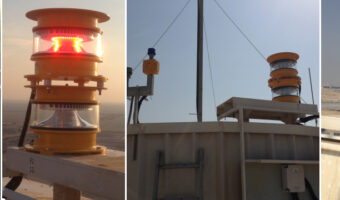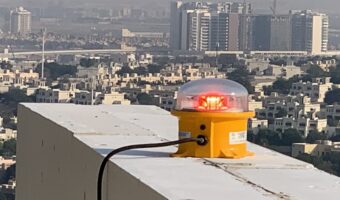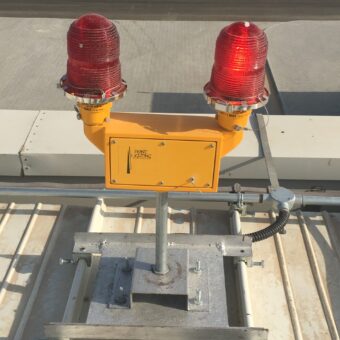AIRCRAFT WARNING LIGHTING SYSTEM DESIGN, NOC, SUPPLY & INSTALLATION REPAIRING OF AVIATION LIGHTS OF ALL TYPE OF MODELS/BRANDS
Dubai Civil Aviation has recommended to install the minimum Aircraft Warning Lights considering the height and location of site/application. The type of light and quantity must comply with Local Civil Aviation approval.
We provide designing service with minimum requirement as per Civil Aviation regulations for Consultants and our Clients at free of charge.
Ex: We have obtained Dubai Civil Aviation NOCs for no lights (exemption of aircraft warning light) for our customer (consultant) for WASEL Tower and De Mo Re Tower at Jumeirah Lake Tower, Dubai.
Aircraft warning lights are lighting devices used to make tall structures more visible to aircrafts, during both daytime and nighttime. These devices should have specific features, in terms of light intensity, beam pattern and light colour defined by international regulations and national standards. The proposed paper provides an overview of the most important guidelines defining lamp types, location and operation of lighting devices. Some layout examples are also included depicting common light configurations on structures.
Aircraft Warning Light/Obstruction Light/Aviation Warning Light
Lamp/Light Types
A first distinction made in regulations is related to lamp types. According to ICAO, standard light units are distinguished by a set of parameters: light intensity, beam pattern, light color, flash rates.
ICAO divides lamps into three main groups:
Low intensity obstruction lights: these lights should be used where the object height is lower than 45mtr from ground level.
Medium intensity obstruction lights: should be used where the object height is above 45mtr from ground level.
High intensity obstruction lights: these lights should be used where the object height is above 150mtr from ground level.
In detail, the regulation describes different lamp types within the above three groups.
Low intensity obstacle lights, on fixed objects, are fixed-red lights divided in two types:
– Type A : with minimum intensity of 10 candelas.
– Type B : with minimum intensity of 32 candelas.
MEDIUM INTENSITY obstacle lights are divided into three types:
– Type A : white color flashing lights with intensity of 20.000 candelas during daytime, 2.000 during nighttime.
– Type B : red color flashing lights with minimum intensity of 2.000 candelas.
– Type C : red color fixed lights with intensity of 2.000 candelas.
HIGH INTNESITY lights are divide in two types:
– Type A : white color flashing lights, with minimum intensity of 200.000 candelas during daytime, 20.000 candelas during twilight and 2.000 candelas during nighttime.
– Type B : white color flashing lights, with minimum intensity of 100.000 candelas during daytime, 20.000 candelas during twilight and 2.000 candelas during nighttime.
Moreover, regulations provide details for every characteristic of each type of obstacle lights, defining vertical beam spread, intensity at given elevation angles, flashing intervals and flashing duty cycles.




